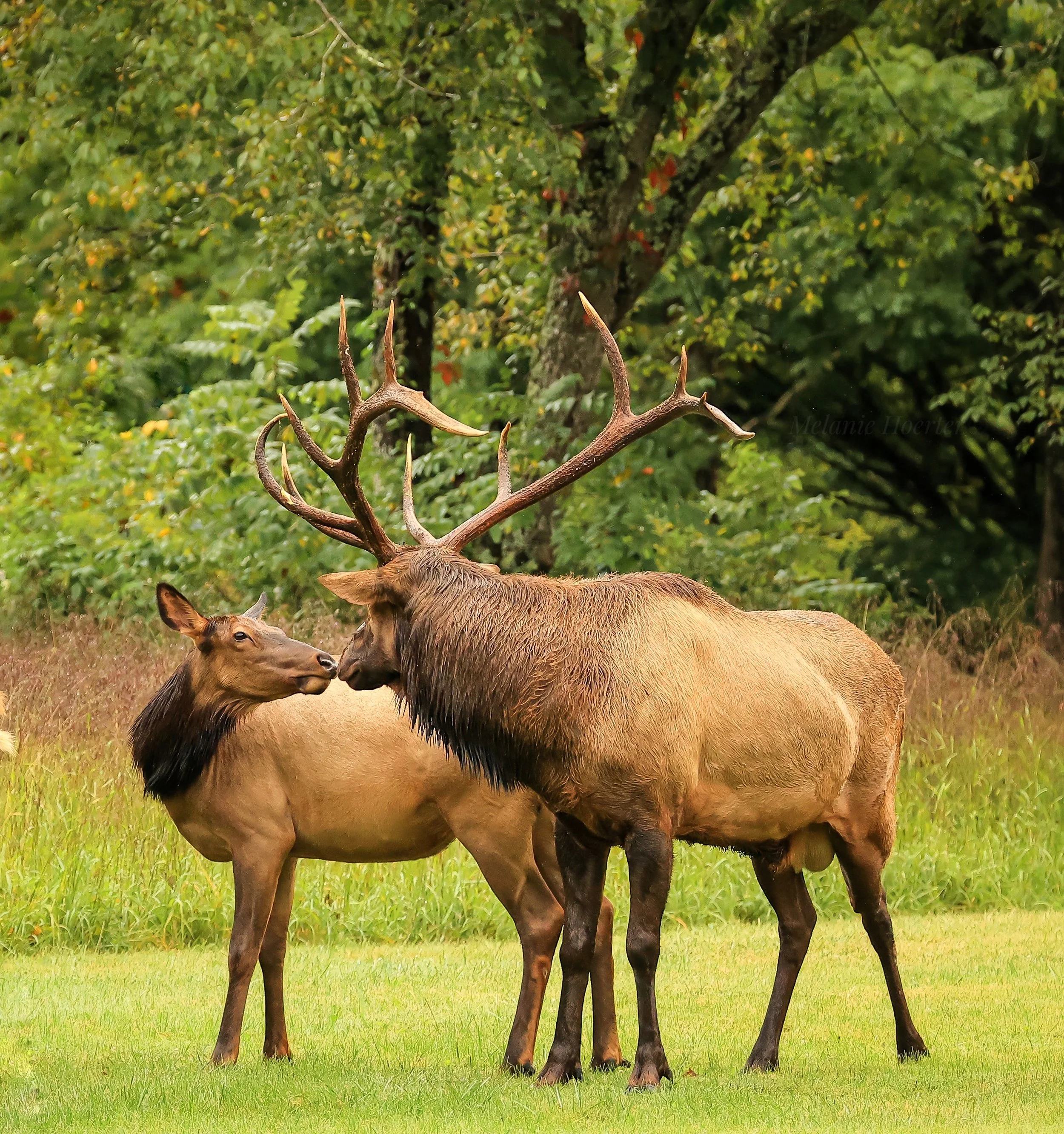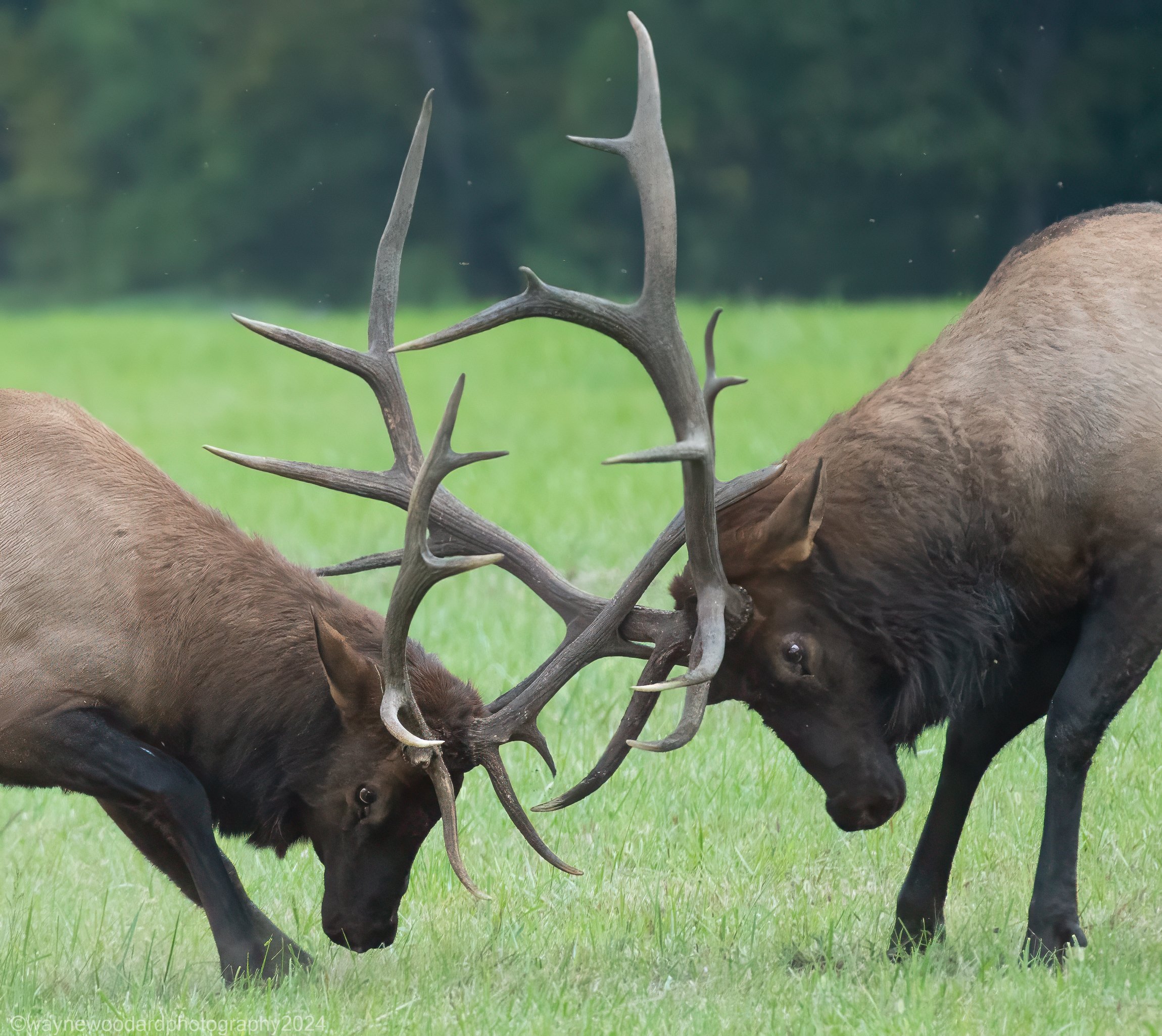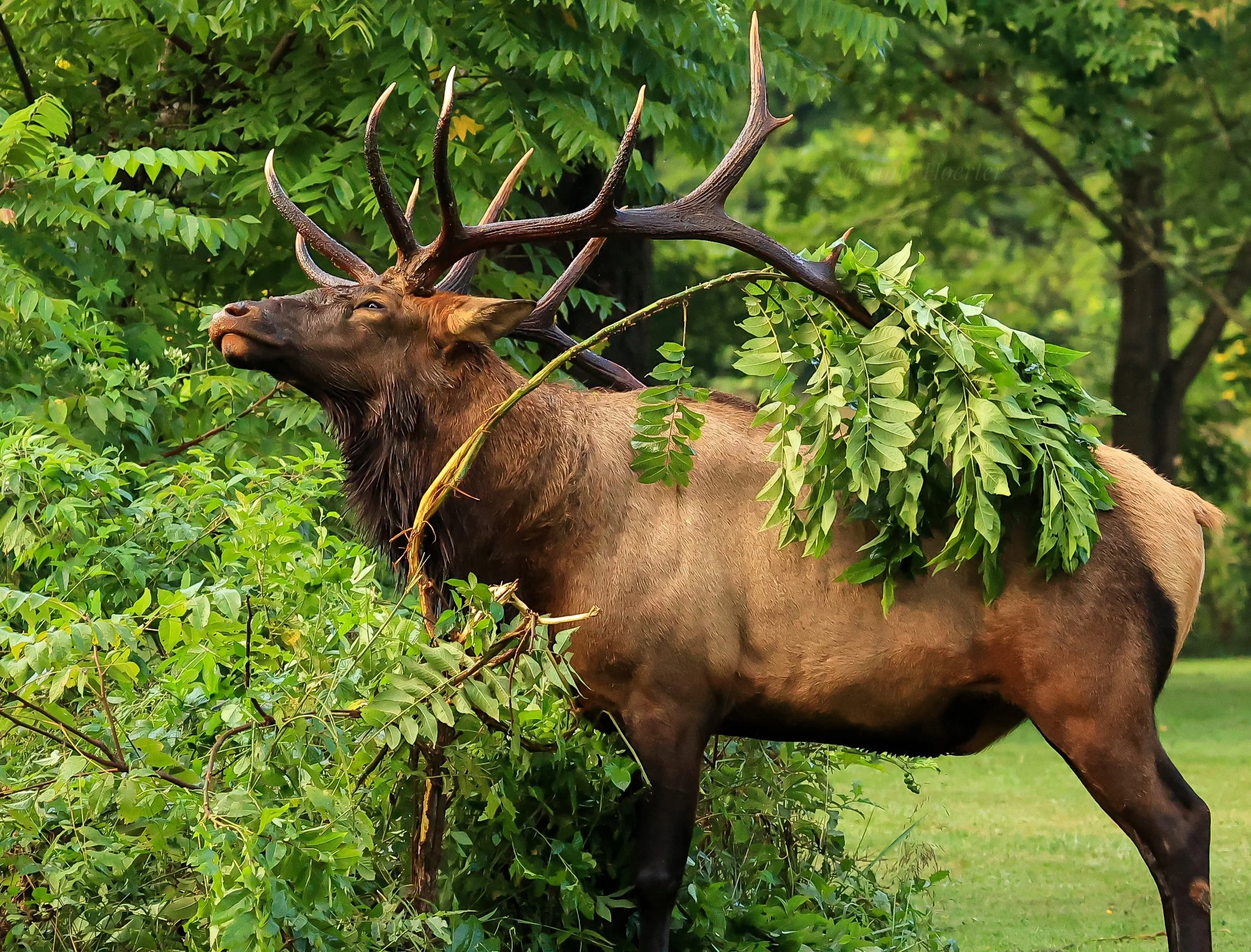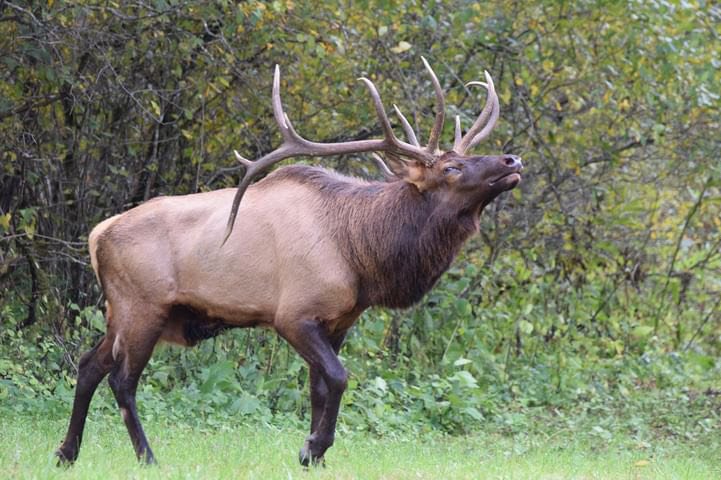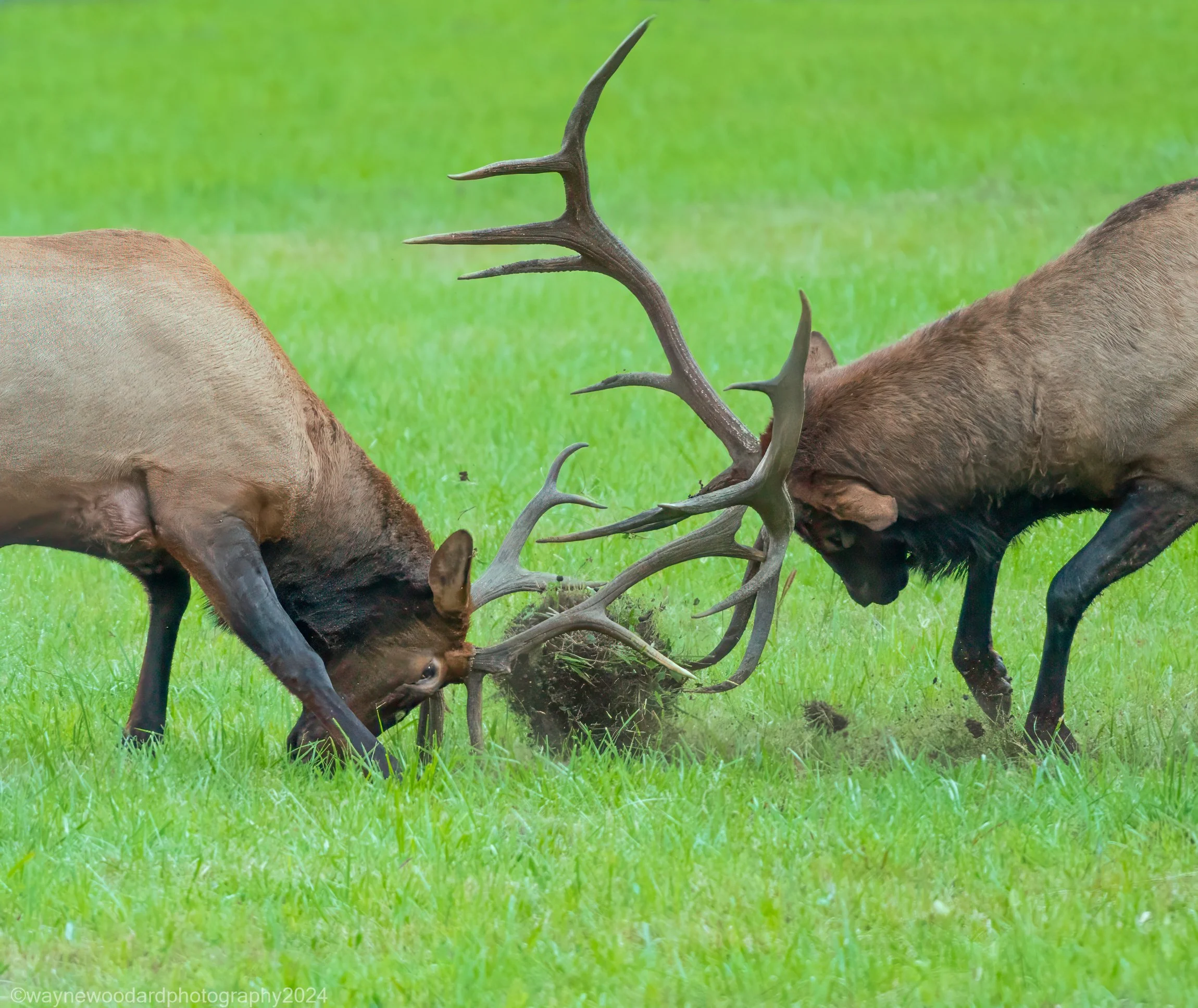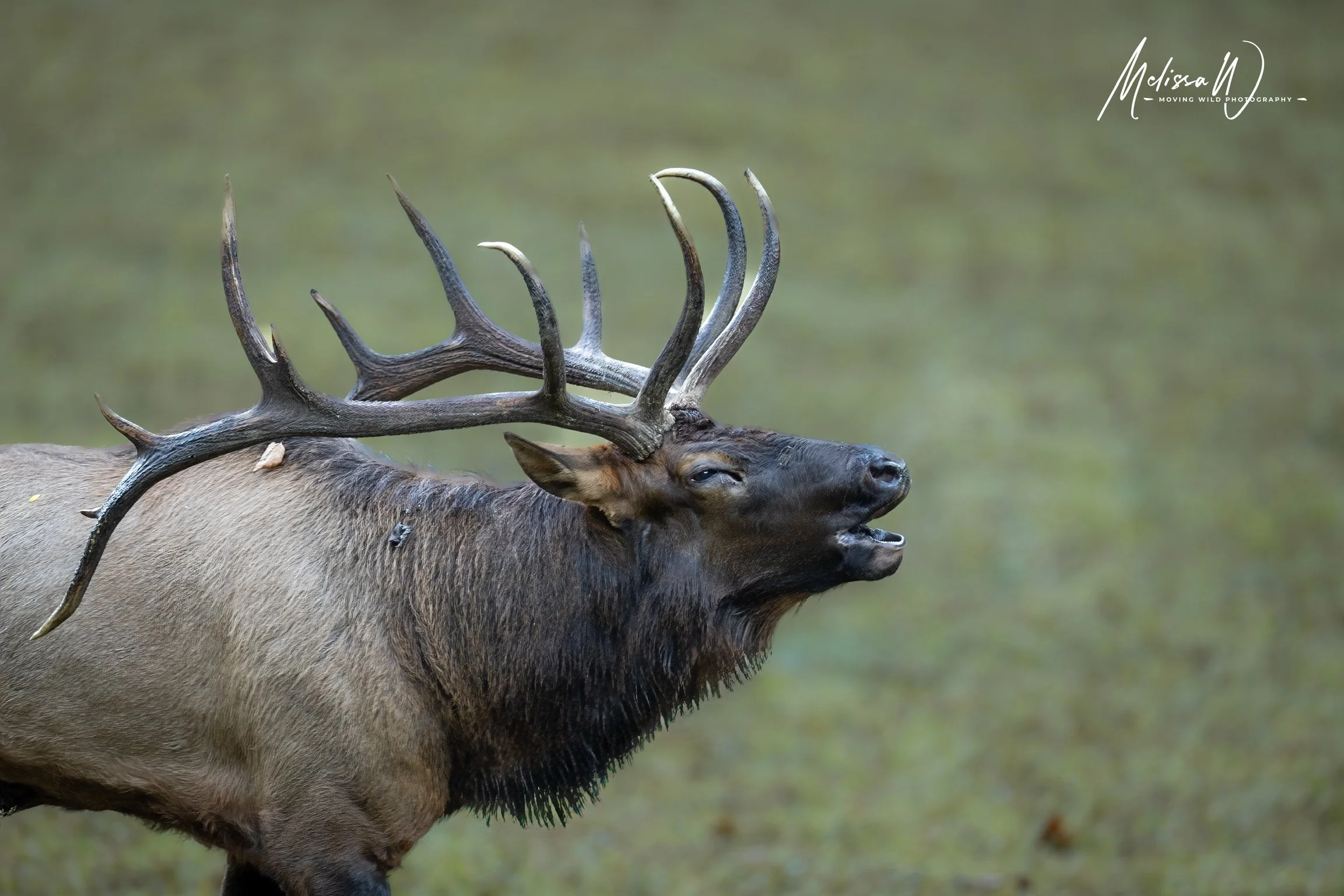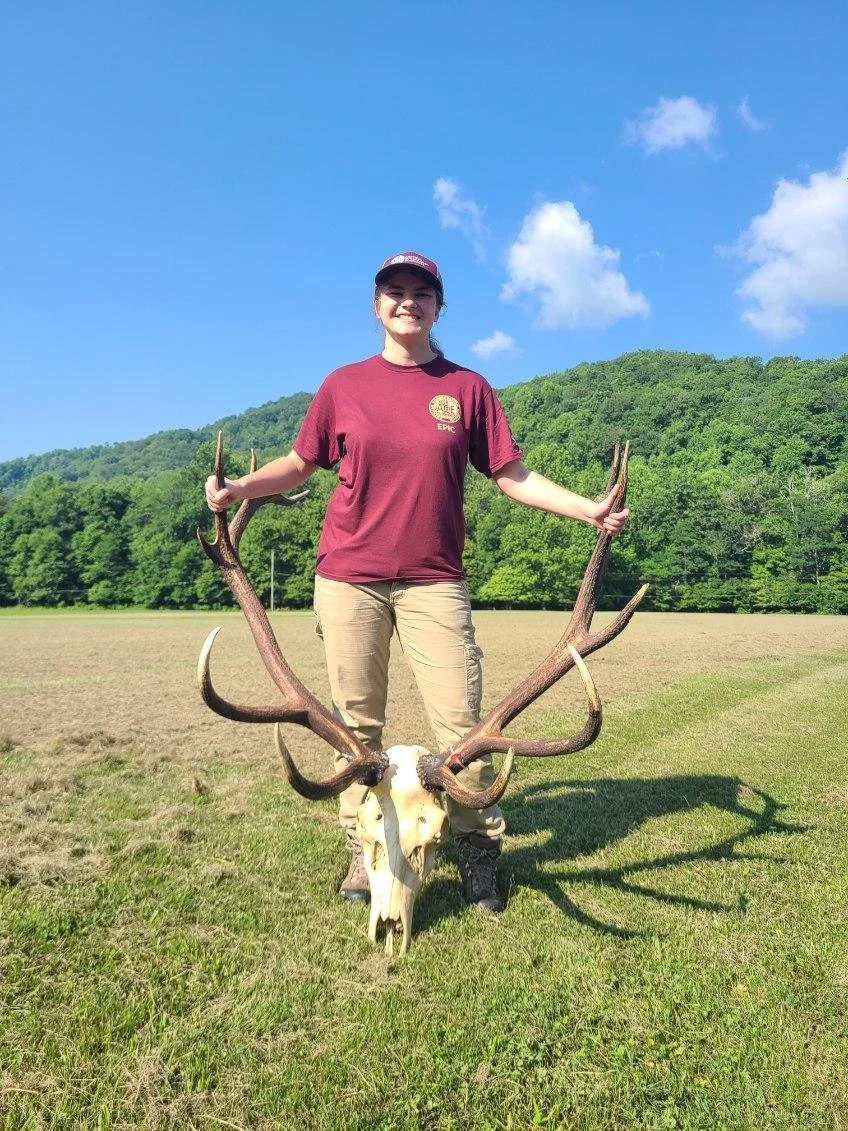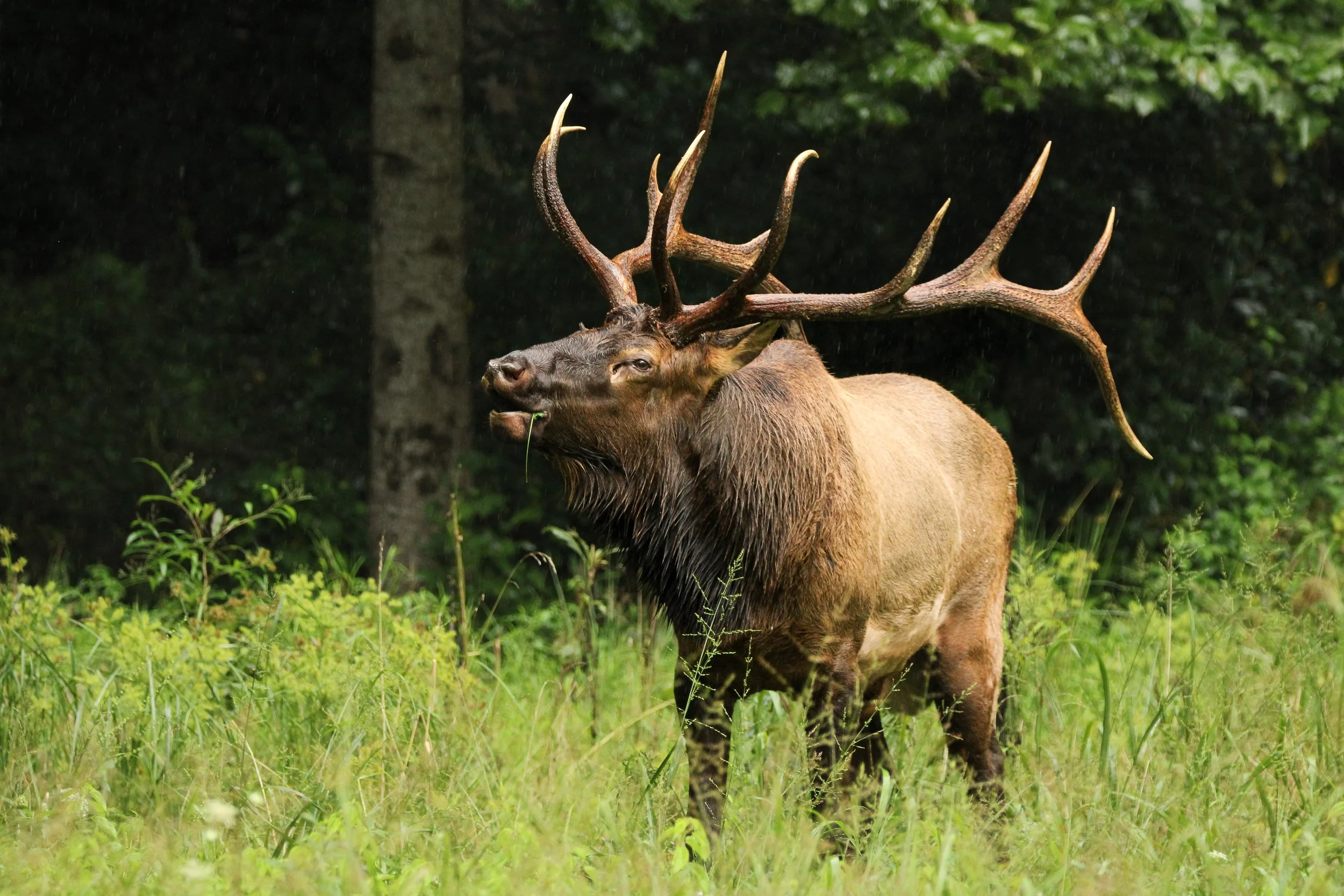Big B - Remembering the Benevolent Behemoth and King of Oconaluftee
Image: Big B on a rainy day in the fall of 2022. I always had a difficult time capturing him in his entirety in frame!
There is nothing quite like a foggy October morning in Great Smoky Mountains National Park. The temperatures struggle to tread above freezing, and a persistent silver sheen of frost clings to freshly-mowed grass. A male red-winged blackbird sings his song as the sun peaks above the distant ridge, blanketing the valley in a golden glow. The unusually turbulent Oconaluftee River is rushing with last night’s rain, white-capped waves sending up a cloud of equally bright spray.
It is here, at the river’s edge, that I sit with my camera in hand. I’m bundled up in my father’s oversized camouflage jacket and trying to keep my ankles warm after forgetting to dress in appropriate socks that morning in my race to get out of the door. In hindsight, the cold stone beneath me doesn’t help. I must have looked like a sorry sight to the two other photographers with me, who are far more prepared than I am with puffy jackets, gloves, and, yes, long wool socks.
We’ve been waiting by the water for at least half an hour, listening to branches snapping about forty yards ahead of us. The foliage is thick enough that we can only occasionally see the glint of brown eyes or the shine of dew-flecked fur catching in the sun. The elk are here, and we’re hoping that they’ll make a move across the river soon.
A crash of dead leaves and hooves echoes, and a young female tears through the brush. She plunges into the river, the cold water lapping at her mane as her belly becomes submerged. Her eyes go wide and she curls her lip, but she’s able to swim across. A yearling follows her lead, and then another cow, and another. Camera shutters buzz behind me, but I’m trying to be patient. At least twenty have braved the whitewater so far, but none of them are the one I’m looking for.
“Where is he?” one of the photographers whispers. They’re waiting too, but not for the same reason that I am.
“I dunno. He was in the field with them earlier. I thought I saw him just a minute ago.”
I’ve turned my attention to the elk that are huddled along the opposite shore. They, too, appear to be getting antsy.
Then there is a sound that I can never forget. It’s a shrill tune, starting at a low rumble and crescendoing into a high-pitched cry. It bounces off of the oaks and sycamores, dancing across the towering mountaintops and reverberating against the very rock beneath me.
I’ve heard this bull’s bugle many times, but I had never felt it in my bones like I did at that moment.
Then he appears. I recall a flash of panic when I realized just how close he was. He’s only about fifteen feet from me, one leg already in the water. He takes another stride, muscles rippling under a grizzled pelt of dark fur. The antlers that crown his broad head swoop down over his back like the ancient mountains he calls home, shimmering with raindrops in the early morning light.
He turns towards us, and I can see the black of his rectangular pupil boring into my own. All of the research I had done in case of a close encounter seems to have vanished from my mind. I try pushing myself up the rock to put distance between us, but the bull’s ears flick forward. Not a good sign. I resign myself to my fate and decide, instead, to sit as still as possible and hope that he’ll pass.
The photographers behind me are able to move onto the riverbank. His nostrils flare, and I can hear his breath. It sounds like a roll of thunder. I don’t know if he’s deciphering our scent or the pheromones of his cows across the river, but I’m praying that it's the latter.
He bends his great neck down and begins to drink. This is, perhaps, the moment that any sane person would have run. However, I (foolishly) stayed poised on the rock. I would like to say that it was only because I was worried of what his reaction would be if I dared to move but, really, there was a part of me that was awed at being so close to an animal I had revered for years. He was so popular that he had even been given a name; “Big B,” short for “Big Boy.”
Big B lifts his head and bugles again, rivulets of water cascading from the corners of his mouth. The herd gathered across the river understands his signal, and they move deeper into the forest to prepare for their midday nap.
One confident step after another, B makes his way across the raging whitewater. Currents that had soaked cows up to their necks and pushed yearlings down the river hardly slow him. He forges a route through a deep hole, cooling off after a long morning of chasing upstart males and wooing his harem. He gives one final bugle along the rocky riverside before ushering his girls into the forest to rest for the afternoon.
Image: Big B bugling. I always thought that he had the most beautiful voice, and I think most people would agree!
When people google “Great Smoky Mountain elk,” chances are that an image of Big B pops up. It is no exaggeration to say that he was likely the most photographed elk in the Appalachians for a number of reasons. Let’s go ahead and talk about the elephant - or, in this case, bull - in the room; B was massive. At one point, park biologists weighed him in at a little over 1,000 pounds. He was certainly one of if not the largest males we’ve ever had by sheer mass alone, and it showed. He had the thickest set of neck muscles I have ever seen! After he reached his prime, he carried a mane of dark brown fur all year long, a sign of his good health, physical prowess, and dominance.
His antlers were distinguishable from a mile away. They curved downwards and framed his muscular shoulders, with the first two tines on each antler curling like a fishhook. He must have always chosen trees with darker bark to rub his velvet off on, because his antlers were usually stained with an umber color. He rarely had chipped tines, probably because he was an experienced fighter. He had a few scars on his shoulders from old scuffs, but he was a handsome gentleman who always appeared clean and well-kept, even when he once had long grass covering both eyes to look extra striking for the ladies! He was, in every sense of the word, an impressive animal.
Image: Myself posing with Big B’s skull. After he passed away in 2022, park biologists saved his skull to use for educational programs. I like to think that Big B is still inspiring visitors to this day!
When elk first discovered the riparian forests and lush fields of Oconaluftee, B was one of the first “big boys” to take advantage of the low competition and surplus of resources in the valley. In these fledgling years, he began to establish himself as a regular in the meadows along the highly-trafficked 441. Visitors were impressed and awed by his large size, beauty, and comfort around humans. Our elk today are very habituated to people, but this wasn’t necessarily the case at the beginning of the reintroduction. Elk would occasionally feed close to the road, but they were more weary of our presence. Big B was very unique in this way. It’s no wonder that he was a favorite subject of wildlife photographers!
Big B may have been well-behaved in front of a camera, but in his younger years he was a menace to park biologists! They first tagged him with the letter “B” in 2013 after deeming him a “nuisance” animal. He had an unfortunate habit of picking fights with cars, leaving a trail of broken doors and angry tourists in his wake. I can even recall one hilarious story from one of the rangers who watched B charge at an impatient eighteen wheeler who had the audacity to honk at him. One summer, after ramming into one too many vehicles, the wildlife team decided to teach this big guy a lesson. How do you teach a 1,000 pound testosterone-driven animal anything, you might ask? Well, you hurt his pride! Once tranquilized, biologists went in and sawed off his antlers (which we still use for education programs). Big B was not physically injured, but his ego certainly took a hit. In the years to follow, he kept his door-destroying tendencies to a minimum, much to the relief of NPS officials!
As Big B continued to grow, so did his popularity. He was perhaps the first elk that visitors, hobbyists, park rangers, and biologists all referred to by name. People traveled from across the east coast in the fall in the hopes of catching a glimpse of B in action. Locals posted images and videos of him traveling through their backyard in the spring and summer to Facebook groups. He was a celebrity in the Cherokee and Bryson City community! Even before I began my wildlife photography and elk research journey, I had heard tales of Big Boy.
Video: Big B crossing the road. Just look at the muscles rippling with each step!
The Oconaluftee herd grew quickly throughout the 2010s. Competition was ramping up as other bulls (many of which were likely B’s own sons) reached their prime. Big B defended his herd and his title with strength and diligence. He stood tall above every challenger, and any usurper who dared to oppose him was swiftly put back in their place. It was a thrilling sight to watch him shove the heads of other bulls into the ground without breaking a sweat, the force of his charge chipping off parts of their antlers. He was getting older, but he still ran and fought with the spitfire of a bull half his age. Soon enough, B earned himself yet another moniker; the King of Oconaluftee.
B was not too kind to other bulls, but there was a benign side of him when he was with his girls. Younger males were brash, but Big B won his cows over with amiability, especially with their calves. I remember an instance when B was laying down in the field and a swarm of half a dozen calves stood around him. They would sniff at his antlers before scrambling back a few steps, then repeat this game of “who can get closest to the big guy?” over and over again. He would greet them with a playful dip of his head, sometimes deciding to take a quick nap while the little ones continued their antics. Big B was a dutiful herd bull (in other words, “lead male”). He took time to check up on each of his girls. He didn’t spend too much time herding them around because they enjoyed his presence, especially when the only other options were the chaotic and energetic youngsters. This is why I refer to him as a "benevolent behemoth,” and I think it suits him well.
Image: Big B bugles on a rainy September day in 2022. This was his last rut season before his passing, and he was just as vocal as he was ten years ago!
Many photographers I have talked to have told me the same story; when they came to the Smokies and saw Big B for the first time, they were hooked. This is a sentiment that I am very familiar with. I credit B with being a catalyst for my elk obsession. He was a treat to watch in person, and I can very clearly remember counting down the minutes until I could leave every day in high school just for the chance to see him. And don’t just take my word for it! A good friend of mine, Elizabeth (@elkwhispererphotography) was kind enough to share her memorable first encounter with B.
“I was walking down the river trail about four years ago, and was warned by a gentleman that there was a large bull elk right on the trail around the corner from where I was. Carefully, I made my way to where he had said, just to find B in all of his glory, using a branch to remove the last bit of velvet from his grand antlers. It was early August, not quite time for him to be in full rut mode, but I was still wary. He began to walk towards me, and I had nowhere to go, so I ducked behind a tree just off the path where I would be partially hidden (or so I thought) from view. I had knelt down, and when I stood up for a brief moment to see where he had gone, he was directly in front of me, giving me that side-eye stare he’d sometimes get. We locked eyes for what felt like hours, and then he went on his way, seemingly uncaring of the awestruck human who had stepped into his world.”
Big B didn’t know it, but he likely inspired thousands of visitors to care about and protect elk in the park and beyond. There is something special about witnessing an animal as incredible as B live his day to day life. I have lost count of how many people I have overheard through the years talking about how amazing he was and, by extension, how amazing his whole species is. He was an ambassador whose very existence affirmed the importance of protecting natural spaces.
His decade-long reign was something to behold. But, as with all good things, it couldn’t last forever. Big B had outlived the average life expectancy of elk, but in that final year his age was starting to show. He didn’t loose that balance of fire and benevolence that drew me to him in the first place, but he was tired. He couldn’t run like he used to and his struts betrayed stiff muscles and old, worn bones. In the fall of 2022, I had the heartbreaking realization that this would likely be B’s last rut.
Video: Big B standing proud just a few weeks before he passed away. I am forever grateful for these final encounters with him.
From then on, every experience I had with him was that much more important to me. I didn’t expect for him to come back to Oconaluftee once summer ended. Ordinarily, old bulls of his age would travel up the mountains into the backcountry to live out the rest of their life in peace. Though, knowing B, I shouldn’t have been as surprised as I was to see him standing near the Visitor Center at the beginning of September with a small harem of old cows at his side. He was always full of surprises and surpassed every expectation, even in his final months.
I could tell many stories of Big B that season, but for the sake of brevity, I will only mention one. It was October, and this was the last encounter I ever had with Big Boy.
When I first saw him that morning, fatigue seeped from his body. He was so exhausted and in incredible pain from a swelling that had built up along his underside, and it was hard to see him in such a state. Despite this, he was keeping a close eye on a younger male who had his sights set on B’s small herd. The King bugled a few times, a song just as harmonious and powerful as ever. Then, he did something incredible. With a snort and a charge, he challenged the bull to battle.
Antlers crashed and the two bulls locked together. B was bigger, but this youngster had the advantage of age. He pushed Big Boy back, and there was a moment when I thought I would see him loose a fight for the first time in his life. But, as we have already established, nobody should ever underestimate him. B dug his hooves into the earth and rushed forward. The young bull scrambled to gain traction. Big B was shoving so hard that his nose slammed into the ground, sending a trail of blood ebbing from his nostrils. The challenger was defeated and, after a short chase, turned tail and fled into the forest. Big B, bloody and heaving, had defended his crown one last time.
About three weeks later, I would learn from a wildlife biologist that B had passed away shortly after this encounter. Age and that mysterious swelling was the cause of death. He had died about a mile and a half up the road in a quiet spot of forest near the creek. I could not think of a better resting place for the King. They decided to keep his skull, both in remembrance of an animal they had all worked with and admired and to educate future visitors about elk. As strange as it may seem to not allow all of his bones to rest in that patch of forest, I see this as a thoughtful way to respect his life and his impact on visitors and staff alike.
Image: My favorite picture I ever took of B. I love how regal and majestic he looks in this photo with a light sprinkling of rain in the background!
Some may find it strange to care so much about an animal that you only ever observed from a distance. To those folks, I am saddened that they never got to experience an early November morning or warm summer evening with Big B when he was with us. Anyone who ever had that opportunity was deeply affected and moved by his presence and majesty. I don’t think any elk for years to come will have the same impact that B had. His legacy, both in the strong bloodline he fostered and the inspiration he provided for so many of us, will not soon be forgotten. People to this day, even new park staff, have heard about B. They remember him through the images, videos, and stories that we continue to share.
This article was written with the intention to remember and honor Big Boy and his legacy. Below, I have asked for some of the incredible photographers I have met over the years to share their favorite images of B. If you never got the chance to meet him, I hope that you can live vicariously through the collection of photographs below. Please be sure to support each and every one of these awesome people!
Thank you Big Boy, for all that you have done for me. I hope this article captures a fraction of your magnificence and secures your memory for years to come.





